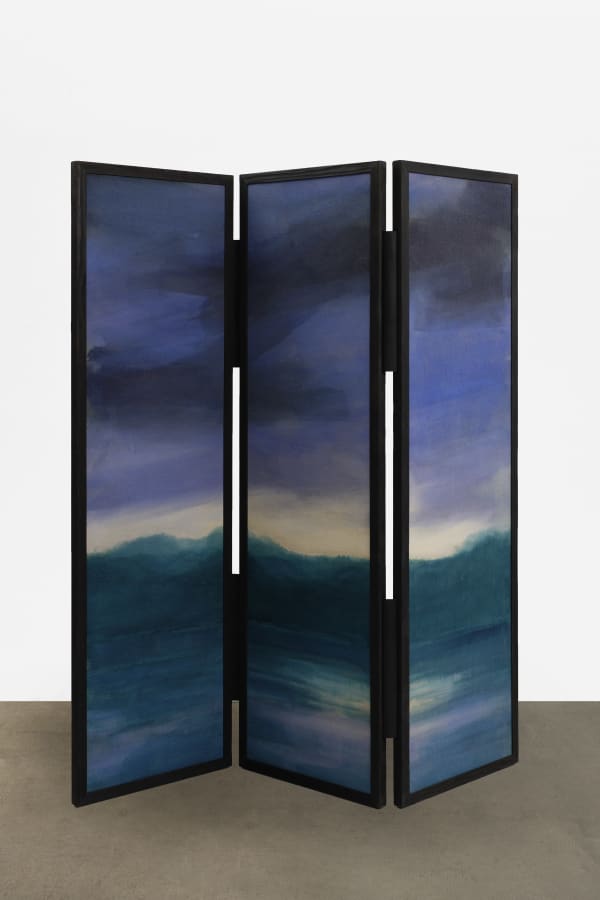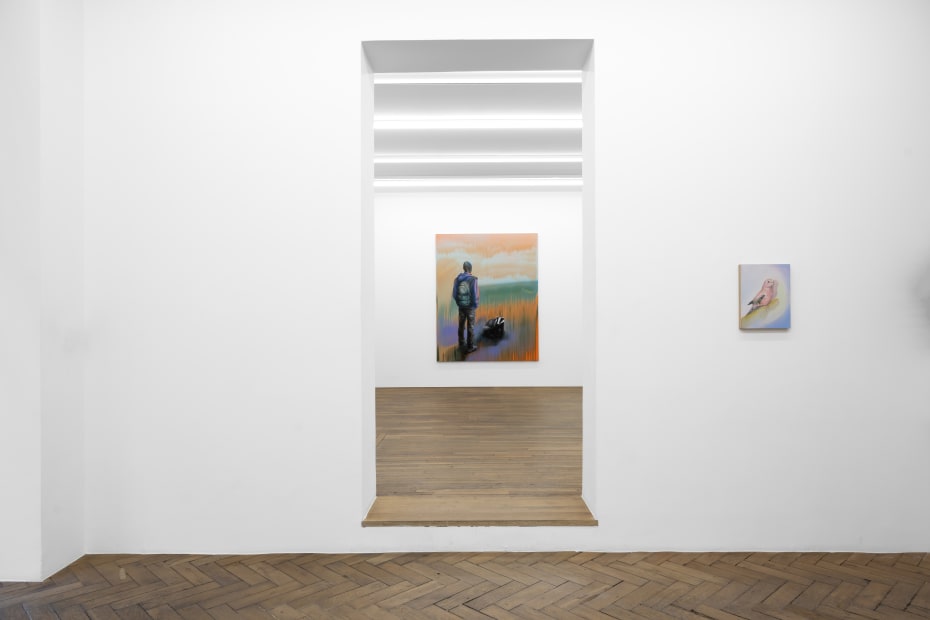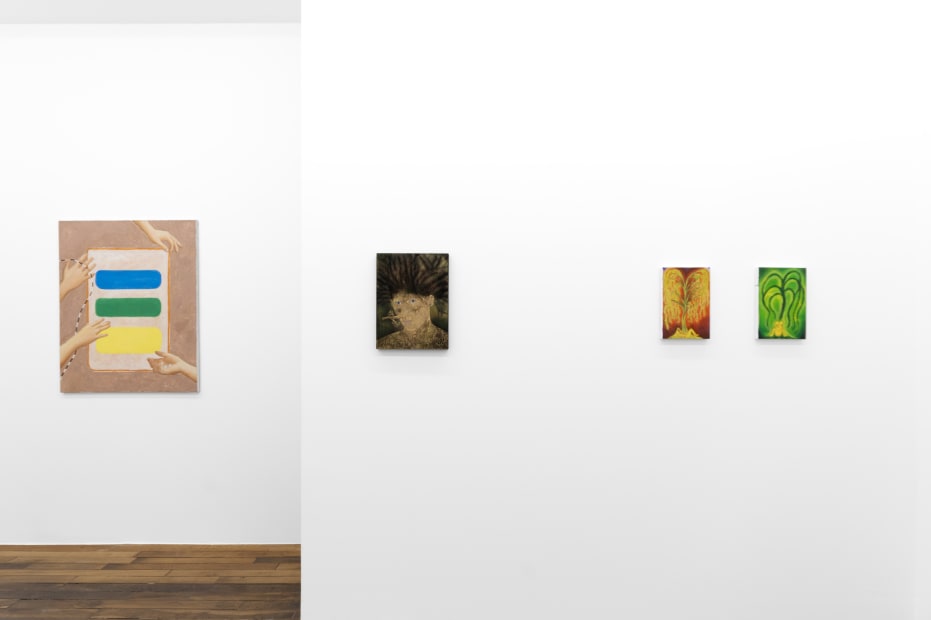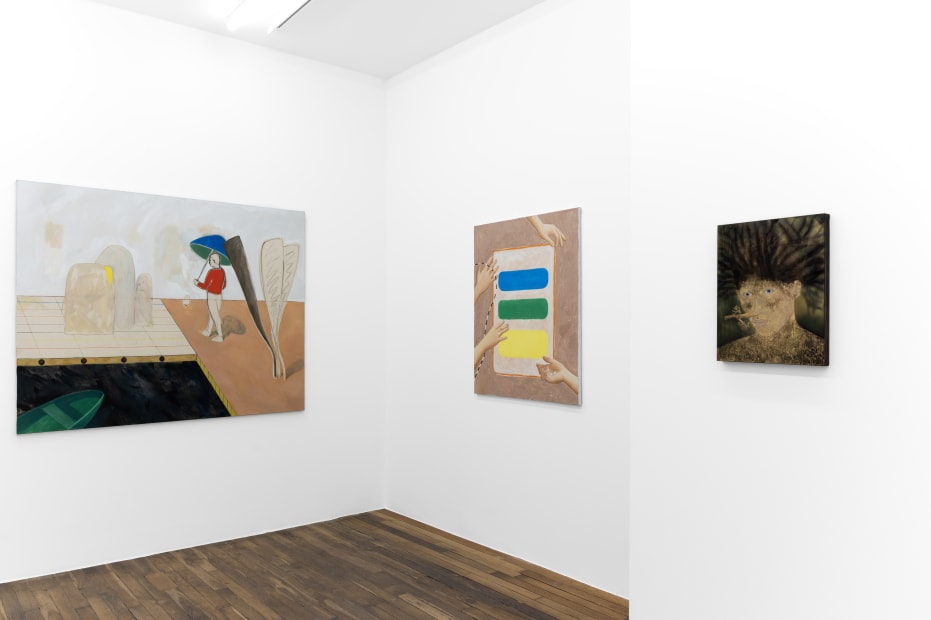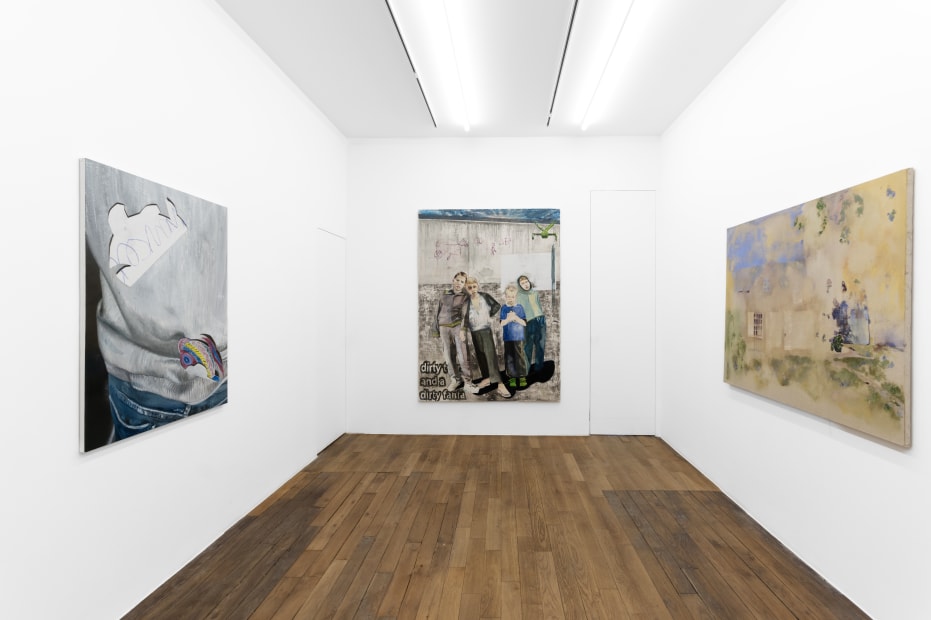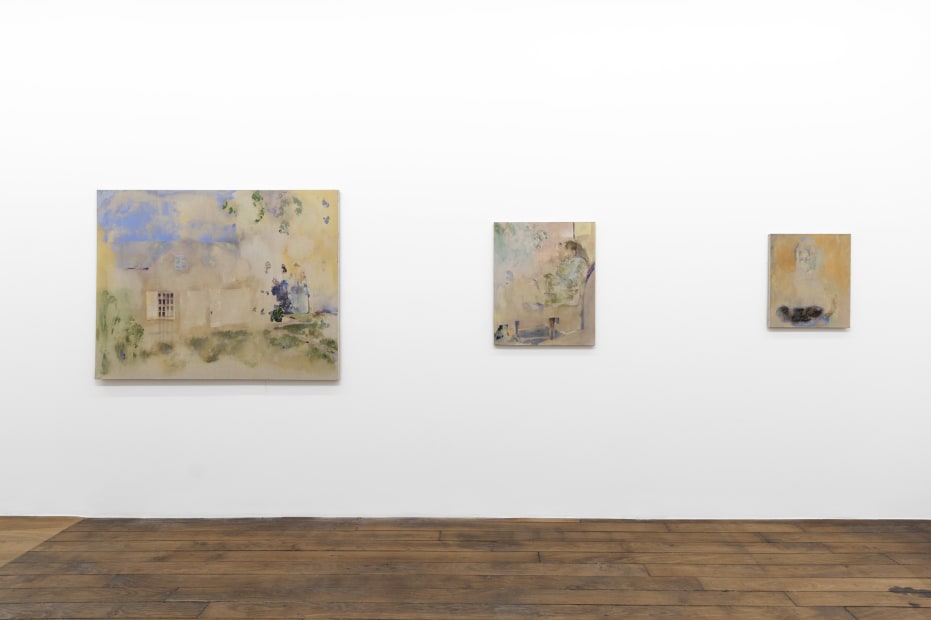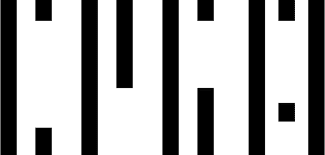Figurative Painting in France Today: Galerie Peter Kilchmann, rue des Arquebusiers, Paris
Annabelle Agbo Godeau, Romain Bernini, Mireille Blanc, Lara Bloy, Djabril Boukhenaïssi, Yoann Estevenin, Cecilia Granara, Lena Long, Sarah Maison, Olivier Masmonteil, Garance Matton and Eva Nielsen.
Figurative Painting in France Today (selection)
September 15 - October 7, 2023
Galerie Peter Kilchmann Paris is pleased to present its first group exhibition, Figurative Painting in France Today (selection), combining 12 French artists whose artistic practices are part of this movement. The recent works explore how the featured artists takes over and renew this genre, both from a technical point of view and in terms of subjects of study and subject matter. The viewer is invited to stroll among architectures and landscapes, to encounter familiar portraits, whose concerns are distinctively current.
Driven by notions of femininity, identity, and by questioning binary concepts, Annabelle Agbo Godeau (*1995 in Paris; lives and works between Paris and Düsseldorf) creates her compositions from fragments taken from images of old erotic magazines, films and personal photographs. She emphasizes how the mass media plays with the image of women by reducing them to a pure consumer product. Too good to be true (oil on canvas, 23x18cm, 2022) tells the story of the perception of the other, the act of self-dramatization specific to the consumption of information and ideals integrated from an early age. In A work of fiction; The Venus Effect and Paola (oil on canvas, 60 x 50 cm, 2022), the recurring blue plunges the figures - often women - into an intriguing darkness. The red lighting is reminiscent of the artificial light present on film sets. By appropriating clichés placed in new contexts and relationships, Agbo Godeau questions her own gendered gaze, and her interest in the representation of women invites the viewer to do the same.
Lena Long (*1997 in Lyon, France; lives and works in Paris) prepares wood panels using calcium carbonate on which she paints in oil. The acid colors then mingle with earthy shades and a chalky materiality of the paint contrast, with the representation of plastic materials. The artist primarily draws materials for their work from the imagery produced by the cultural entertainment industry and other fuel of the image-driven capitalism we live in. She pays particular attention to the end of childhood passing into adolescence, embodying for her "the threshold of violence - psychic, economic, political" where systems of domination can be fatal. This is what we can read on the faces of these young boys represented in KITTEN (oil on wood coated with calcium carbonate, 206 x 153 cm, 2022). The nonchalant attitude, a black eye, dark circles under the eyes, and distant gazes contrast with the fragility of the youngest, innocent, holding a kitten tenderly (but almost too firmly) in their hands. Mama's (triptych, oil on coated wood, 12 cm x 9 cm each, 2023) are packages of instant noodles. Very inexpensive, quick, the inflated Mama logo seems to support the commercial illusion of the link between fast food (instant, regressive pleasure) and maternal comfort.
Sweatshirts, cakes, kitsch trinkets, are recurring motifs in the work of Mireille Blanc (*1985 in Saint-Avold, France; lives and works in Évry). It is the specific quality of these objects and their enigmatic aspect that interest her. There are shifts between the subject matter, the object, and the question of the figure: then the body which is often only exists in fragments, or manifests itself by its absence. In Poissons d'Avril (oil and spray on canvas, 120 x 90 cm, 2022), a person’s back hosts two paper fish. These objects play on flatness or patterns of clothing that are initially obvious but become abstract when worn. They particularly interest the painter in that she blurs the subjects which then only reappears through clues.
The work of Sarah Maison (*1990; lives and works in Paris) questions the body in its materiality and its attributes of appearance. Through intertwining colors on the canvas she creates spaces for her figures. These undefined, timeless places are decluttered from narrative elements. Solitude in Berlin (oil on canvas, 140 x 160 cm, 2021) shows two characters whose only attribute is that of the colors that envelop them. The voids that separate them are purely material spaces, alternative and dense places. The reclining or sleeping figures - almost disappearing - are lost in an in-between, a tangible solitude, S'évanouir (oil on canvas, 20 x 20 cm, 2022) and Blue Note (oil on canvas, 18 x 27 cm, 2023) recount the feeling of no longer being in the world, of having a desire to be erased. On each of the paintings, the body of the characters is present and alive but their souls seem to be watching for a place that they are desperate to find.
Lara Bloy (*1992 in Toulouse, France; lives and works in Paris) works around the themes of floating states and introspection. Égarée XXXIV (oil on canvas, 60 x 60 cm, 2023) is part of the eponymous series begun in 2020. It features female models, friends of the artist, who evolve in worlds of weightlessness where tension and relaxation interchange. The poses of the characters are inspired by experiences lived by Lara Bloy: climbing, descents of canyons, road accidents. These moments when our relationship to gravity and time appears suspended or disturbed and almost enter the concept of ataraxia that developed in Epicurean philosophy. It designates the peace of the soul, characterized by an absence of bodily and spiritual disorder. It is a kind of parallel state that the artist also compares to a state that can be experienced in front of screens; a hypnosis that leads to artificial self-immerison. Litote III (oil on canvas 100 x 73 cm, 2023) is an exception to the artist's work. The painting is developed in several stages: filtered from the initial photo, then from a digital file, and then finally from a pictorial layer. The uninhabited room with its messy bed is disturbingly strange. The metamorphosis of the familiar is supported by almost imperceptible deformations (stretching, elongation, blurring) of the elements of the representation.
The work of Djabril Boukhenaïssi (*1993 in the Paris suburbs; lives and works in Paris) is essentially inspired by literature and music. It revolves around the concepts of disappearance and fragility. His painting reconstructs sensitive images whose content nourishes his relationship to the world. His painting appears indecisive, only halfway to a successful representation. It evokes evanescent, fragile events, faintly registered within ourselves. He hypothesizes that painting worked through "perforated" porous patterns that themselves are crossed by other patterns and manifests the way in which the interior images come back to us in a duration that is specific to us. The duration of all the relative is apparent. The use of pastel is essential in his work. Its porosity on the glazes of the oil paint and its transparency do not collect on the same plane the colors and the patterns of the composition.
The iconography of Yoann Estevenin (*1992 in Cagnes-sur-mer, France; lives and works in Paris) is nourished by plural mythologies, symbolism, circus, magic, rock & roll, eroticism, religion, witchcraft, cinema and poetry. In multidisciplinaric fashion he likes to summon singular identities in his sculptures and his pastel drawings. Fantastical faces and bodies augmented with symbols, colors, shimmering, and mysterious adornments are never quite reassuring or comfortable - but they are not repulsive either. On the contrary, his works evoke a fascinating strangeness. From Latin fascinare: charm, understood in the sense of bewitching power.
The painting of Cecilia Granara (*1991 in Jeddah, Saudi Arabia; lives and works in Paris) draws on autofiction, poetry and symbolic iconography. She is interested in cultural attitudes regarding sexuality, corporeality, and femininity. To her color is a vector of emotions. The patterns are cyclical: butterflies, eyes, genitals unfold in compositions that recall how soothing it is to reconnect the individual to the environment that surrounds him. Her paintings are welcoming territories that are sometimes expressing suffering and anger. However, the meditative experience through her work finally allows communion and the overcoming of these emotions.
Olivier Masmonteil (*1973 in Romilly-sur-Seine, France; lives and works in Paris) builds his personal mythology around three subjects: landscape, art history, and fantasy. For this exhibition, the artist presents Paravent sunset #2 (acrylic on linen canvas, burnt wood frame and black leather hinges, 3 panels, 187 x 55 cm each, 2023) in collaboration with interior designer Aurélie Benbassat. It is an exploration of inscribing the process in the object and the object in space. A landscape unfolds on 3 panels and recalls the fascination of the painter, of all painters, for the horizon line and these blue hours. The piece of furniture calls for tranquility and promises it by exposing itself to hide us.
Garance Matton (*1992 in France; lives and works in Paris) challenges the limits of representation by bringing together sensations of depth and flatness within the same canvas. By manipulating perspectives, the superposition of planes and the fragmentation of forms, she disrupts the conventional hierarchy of compositions. However, her work perseveres with a narrative dimension that projects the viewer into an ambiguous space and temporality. This approach contributes to the exploration of a wide range of pictorial gestures at different degrees of realism or abstraction and allows the viewer to simultaneously savor the carnal and visual pleasure of painting.
The works of Eva Nielsen (*1983 in Les Lilas, France; lives and works in Paris) blur the boundaries between painting, photography and screen printing. The artist explores the possibilities of these mediums to modify the perspectives of reality. Nielsen's works evoke utopian and timeless landscapes. She works from a body of photographs, personal memories and dreamlike idylls. She then overlays these landscapes with industrial structures, particularly elements of sewage and waste treatment systems, which frame and soften the underlying images.
The painting of Romain Bernini (*1979 in Montreuil, France; lives and works in Paris) deal with ecstasy, color, and what is near and far. His work is simultaneously nourished by the Color Field, the Primitive Arts and a psychedelic syncretism. Whether it's lush and enigmatic landscapes, fictional contemporary Shamans, or layered in mysterious and strange spaces, Romain Bernini's works show a section of the world that is animated by a story that celebrates utopia and rituals.
For further informations, please contact Audrey Turenne - audrey@peterkilchmann.com
-
 Annabelle Agbo Godeau, Paola, 2022
Annabelle Agbo Godeau, Paola, 2022 -
 Annabelle Agbo Godeau, Mauvais œil, 2023
Annabelle Agbo Godeau, Mauvais œil, 2023 -
 Romain Bernini, Reason To Believe, 2023
Romain Bernini, Reason To Believe, 2023 -
 Romain Bernini, Territory?, 2020
Romain Bernini, Territory?, 2020 -
 Mireille Blanc, Poissons d'avril, 2022
Mireille Blanc, Poissons d'avril, 2022 -
 Lara Bloy, Egarée XXXIV, 2023
Lara Bloy, Egarée XXXIV, 2023 -
 Lara Bloy, Litote III, 2023
Lara Bloy, Litote III, 2023 -
 Djabril Boukhenaissi, Ronthon, 2023
Djabril Boukhenaissi, Ronthon, 2023 -
 Djabril Boukhenaissi, L’écoute musicale, 2023
Djabril Boukhenaissi, L’écoute musicale, 2023 -
 Yoann Estevenin, Smoky Doll, 2023
Yoann Estevenin, Smoky Doll, 2023 -
 Yoann Estevenin, The wooden Prince, 2023
Yoann Estevenin, The wooden Prince, 2023 -
 Cecilia Granara, Forest bathing (Mexico), 2023
Cecilia Granara, Forest bathing (Mexico), 2023 -
 Lena Long, Kitten, 2022
Lena Long, Kitten, 2022 -
 Sarah Maison, Solitude in Berlin, 2021
Sarah Maison, Solitude in Berlin, 2021 -
 Sarah Maison, S'évanouir, 2022
Sarah Maison, S'évanouir, 2022 -
 Olivier Masmonteil & Aurélie Benbassat, Paravent sunset #2
Olivier Masmonteil & Aurélie Benbassat, Paravent sunset #2 -
 Garance Matton, Plans, 2022
Garance Matton, Plans, 2022 -
 Eva Nielsen, Phosphène II, 2023
Eva Nielsen, Phosphène II, 2023
















